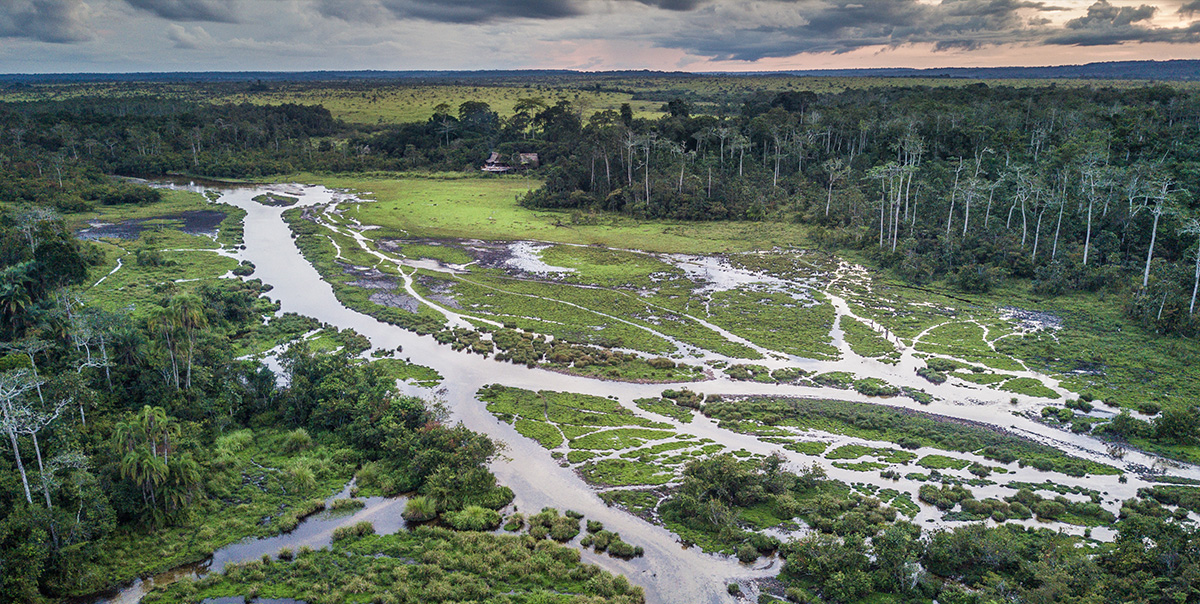They are the foundation of terrestrial life, yet often overlooked. In humid tropical forests, these soils are surprisingly nutrient-poor, with nutrients rapidly recycled through dense vegetation. This process is crucial for biodiversity and ecological balance, directly influencing the plants that grow and, consequently, the animals that depend on them. Discover the essential role of tropical soils in sustaining life.
Soils in Odzala-Kokoua National Park
Introduction:
Soils are vital to every terrestrial biome, providing essential nutrients and support for plant and animal life. In humid tropical forests like Odzala-Kokoua National Park, soils form through millions of years of intensive weathering:
- Chemical leaching: Driven by acidic rainfall and a tropical climate characterized by high temperatures and humidity, it removes soluble nutrients such as potassium, calcium, and magnesium, leaving behind nutrient-poor soils rich in iron and aluminum oxides.
- Mechanical weathering: Including root wedging by plants and physical erosion by rivers, it further shapes these soils. Dense forest roots penetrate rocks, while rivers transport and abrade rock particles, continually reshaping the landscape.
- Biological weathering: Microorganisms and fungi produce organic acids that break down minerals, while extensive plant root systems exert physical pressure, further fragmenting the rock.
Soil Properties:
In Odzala-Kokoua National Park, two predominant soil types significantly influence vegetation and biodiversity
Ferrallitic Soils (Ferralsols)
Ferralsols have a crumbly structure, and support diverse tropical ecosystems, making them vital for studying soil management in tropical agriculture.
- Color: Typically red or yellow-brown, indicating the presence of iron- and aluminum oxides.
- Texture: Clayey to crambly -sandy, well-drained but nutrient-poor.
- Impact: Plants develop specific root systems adapted to the soil conditions, which supports high plant diversity.
Hydromorphic Soils
Hydromorphic soils, characterized by poor drainage, exhibit high water saturation and a dense structure that impedes root growth and oxygen availability, making them essential for understanding wetland ecosystems.
- Color: Blue-green or greyish tint due to prolonged water saturation.
- Texture: Can vary, often includes poorly drained clayey, silty, or sandy layers. Often have poor drainage properties. Found along rivers both, in savannahs and in the forest. The texture often results in poor root penetration and limited oxygen availability (permanently engorged by water) for plants.
- Impact: Very unfavorable to vegetation, supporting specialized plant species adapted to waterlogged conditions.
Root Adaptations :
Ferrallitic Soils:
- Deep Root Systems: These are common in sandy areas where roots penetrate deeper layers to access stable sources of water and nutrients, less affected by surface leaching. This adaptation is crucial for plants to survive in nutrient-poor, well-drained soils.
- Buttress Roots: Large tropical trees develop buttress roots in clayey ferrallitic soils. These roots provide stability in the shallow, nutrient-poor upper layers of the soil and help capture nutrients from the topsoil, supporting the tree's massive structure.
Hydromorphic Soils:
- "Breathing Roots" (Pneumatophores) : In waterlogged soils found along rivers and in swamps, plants develop roots that protrude above the soil surface for gas exchange in oxygen-poor environments, enabling plants to survive in saturated conditions.
- Stilt Roots: Trees in riparian and swampy forests develop stilt roots provide stability in soft, wet soils and increase the plant's surface area to absorb nutrients and oxygen more efficiently, crucial for survival in unstable, waterlogged environments.
Ecosystem Consequences
- Water Retention: Ferrallitic soils drain water quickly, leading to variable water availability for plants. This rapid drainage can lead to periods of water stress for plants.
- Nutrient Cycling: Rapid decomposition of organic material promotes a quick nutrient cycle. Microorganisms in the soil play a crucial role by breaking down organic matter and recycling nutrients back into the soil, supporting plant growth adapted to nutrient-poor conditions.
- Erosion Protection: Dense vegetation and root systems stabilize soil and reduce erosion risks. Ferrallitic soils, with their stable structure, also contribute to lower erosion rates.
Soil Dynamics in Tropical Forests
Tropical forests thrive due to their remarkable soils, which teem with a diverse array of decomposers, including bacteria, fungi, earthworms, termites, and other microorganisms. The consistently warm temperatures and stable humidity of the tropical climate create an ideal environment for these organisms. This abundance and variety of decomposers are essential for efficiently breaking down organic matter and recycling nutrients.
The tropical climate not only supports a high diversity and number of decomposers but also significantly boosts their activity. The steady warmth and moisture promote continuous and vigorous decomposition processes, which accelerates nutrient cycling within the soil. This heightened activity ensures that nutrients are rapidly broken down and made available to plants.
As a result of this dynamic and efficient decomposition, tropical soils experience swift nutrient turnover, which supports lush plant growth and maintains vibrant ecosystems. However, despite the rapid cycling of nutrients, the nutrient cycle is not entirely closed. Frequent rainfall leads to substantial nutrient leaching, and the soils' limited capacity to retain nutrients means that some nutrients are lost from the system before they can be fully recycled.
Humus Layers and Decomposition: Tropical vs. Temperate Forests
In the tropics, the constant warmth and humidity accelerate leaf decomposition to approximately 1 year, resulting in a humus layer that can be as thin as a few millimeters. In contrast, temperate forests, with their cooler temperatures and seasonal changes, see leaves decompose over 5 to 7 years, leading to a much thicker humus layer, often exceeding a meter. This stark contrast highlights how climate influences decomposition speed and humus thickness, illustrating the diverse strategies ecosystems use to manage organic matter and nutrients.
Mycorrhizal Fungi
Mycorrhizal fungi form mutualistic partnerships with plant roots, where both benefit: the fungi supply plants with essential nutrients like water, phosphorus, and nitrogen, while the plants provide sugars through photosynthesis. This relationship is crucial for sustaining plant health in nutrient-poor tropical soils.
Conclusion

We love teaching you about the magic of Odzala-Kokoua National Park.
Sign up to learn more.
If you have any further questions, please visit our comprehensive FAQ section.